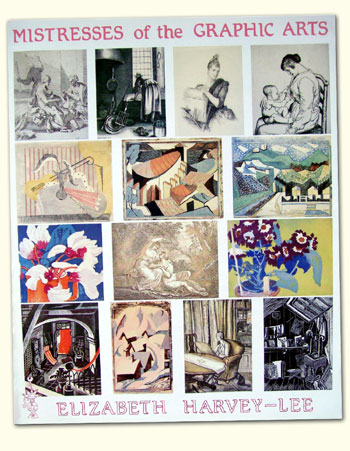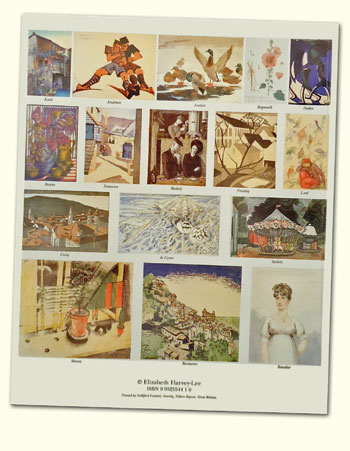|
MISTRESSES
OF THE GRAPHIC ARTS
 Famous & Forgotten
Women Printmakers c1550 – c1950 Famous & Forgotten
Women Printmakers c1550 – c1950
Though it comes as no surprise to discover that European
women have been engaged in artistic activity from time
immemorial, it is perhaps remarkable that they have been
printmakers almost since the inception of woodcut and
engraving in the late 14th century. Printmaking, especially
the intaglio techniques (and the later invention of lithography)
requires highly specialised equipment and materials such
as presses, tools, acid, and involves manhandling heavy
sheets of copper (or weighty blocks of limestone).
The distaff side of the history of printmaking is shaped
by these requirements.
The
earliest women printmakers were nuns. Life in a convent,
without the personal commitments of family life and
household organisation of the lay woman, allowed time
and financial support to produce prints. The need for
illustrations in religious books and for duplicated
holy images to sell to pilgrims supplied a motivation
that encouraged the making of woodcuts. Fruit wood blocks
are soft enough to cut with a knife and hand pressure
is sufficient to print them. The resulting simple outline
images could then be hand-coloured. By the 15th century
convents, like that of Marienwater in the Netherlands,
are known to have acquired screw printing presses to
print both text and pictorial woodcuts.
It was not till the 16th century that women apparently
became involved in intaglio copperplate engraving, but
from the beginning they are recorded by name rather than
being anonymous like their wood cutting sisters. Diana
Scultori working in Italy in the latter half of the 16th
century was the first significant female engraver. In
general, like Diana Scultori, women engravers were all
daughters from printmaking families and like as not married
to engravers or painters too. They had grown up in printing
studios and the equipment and technical assistance was
to hand. Most of the early women engravers were collaborative
or interpretative engravers, assisting the male members
of their families or reproducing the designs of their
fathers, brothers, husbands or other artists. The engravings
of women at household tasks by Geertruyd Roghman in the
early 17th century are perhaps the first original engravings
by a woman being carried out to her own designs. However,
until the 19th century, the majority of women continued
to work as reproductive engravers.
On the other hand women etchers, in keeping with the
freer more painterly traditions of the medium, are more
generally original printmakers. Etching did not have
a wide following until the 17th century and had its roots
in Italy, so that it is fitting that the first important
woman etcher is the 17th century Italian painter Elisabetta
Sirani.
Through
the 18th century several women, like Angelica Kauffmann,
became celebrated artists and the number of women
involved in printmaking increased considerably. In
addition to professionally trained artists and craftswomen
it became a fashionable pursuit for the educated leisured
classes, among aristocratic and royal dilettanti, who
had sufficient money to pay for professional help and
guidance. Angelica Kauffmann was one of only two women
elected to the newly founded Royal Academy in London,
though she would contribute paintings rather than her
prints to the Academy exhibitions. In Revolutionary
France the Salon was opened to women and by 1808 one
fifth of the exhibitors were women so that it was nicknamed
the Woman’s Salon.
In
England the painter Joseph Farington commented on knowing
a circle of women artists who made their living copying,
painting miniatures or engraving and teaching engraving,
though Letitia Byrne complained to him that “there
is a prejudice against employing women engravers”.
 Women were amongst the earliest exponents of lithography
when it was invented in 1798. Lithography allows the
most natural drawing of any of the traditional printmaking
techniques, whether on stone or even more so, on transfer
paper. Lithographic printing on the other hand is complex
and commercial lithographic studios were set up from
the start to which amateurs and trained artists alike,
whether male or female, could repair to have their images
printed. Women were amongst the earliest exponents of lithography
when it was invented in 1798. Lithography allows the
most natural drawing of any of the traditional printmaking
techniques, whether on stone or even more so, on transfer
paper. Lithographic printing on the other hand is complex
and commercial lithographic studios were set up from
the start to which amateurs and trained artists alike,
whether male or female, could repair to have their images
printed.
By
the later 19th century it was not unusual for women
to take up art professionally. In England The Society
for Female Artists was founded in the 1850’s and
had a school to train women. The Etching Revival gave
impetus to original printmaking and specialist intaglio
printers, such as Goulding in London, Delâtre in
Paris and Felsing in Berlin, opened printing studios.
This and the establishment of Art Colleges with printing
facilities and tuition enabled a wider range of women
to take up printmaking, though they tended largely to
come from the professional middle and upper classes,
who could afford the fees. London University’s
Slade art school was the first London art school to admit
women on equal terms.
From
the 1880's women artists of international
stature, such as Mary Cassatt and Berthe Morisot in France
interested themselves in printmaking and in Germany Käthe
Kollwitz made it her primary mode of expression.
England,
more than any other country, saw a surge in output
of graphic art among women art students in the early
years of the 20th century. Through the Etching Boom,
1900-1930, successive generations specialised in etching
at the Engraving School of the Royal College of Art
under the guidance of first Frank Short and Constance
Pott and later Malcolm Osborne and Robert Austin. The
Slade School produced more Modernist painters who also
had a related interest in etching. The Central School,
with the classes of Noel Rooke and Leon Underwood’s
school, had a bias towards wood engraving.
Women
students took to wood engraving in seemingly huge numbers;
many of the greatest names in British wood engraving
are women, Gwen Raverat, Clare Leighton, Gertrude Hermes.
In the 1920's and 1930's the alternative
relief printing technique of colour woodcut had several
leading women practitioners. With the Etching Crash at
the end of the 1920's the disappearance of a market
for black & white prints encouraged the making of
colour prints not only from wood blocks, but in etching
(Elyse Lord, Winifred Austen) and particularly in linocut.
In Claude Flight's classes on linocut at the Grosvenor
School the majority of his students were women. Fewer
women (as indeed fewer artists at all) took up lithography.
Many women only exhibited while they were still students
or in the years immediately following their studies and
then disappear without a trace.
Published 1995
124 pages. 361 prints described and illustrated in b/w
(30 also reproduced in colour on the front and back
covers)
(UK
Price: £15, International orders: £20)
Special
Offer
Purchase
the two catalogues; Mistresses and Unsung
Heroines, together for £27 (UK) or
£35 (International).
See
also the catalogue entitled Eve.
^ Return to the top of this page ^
|